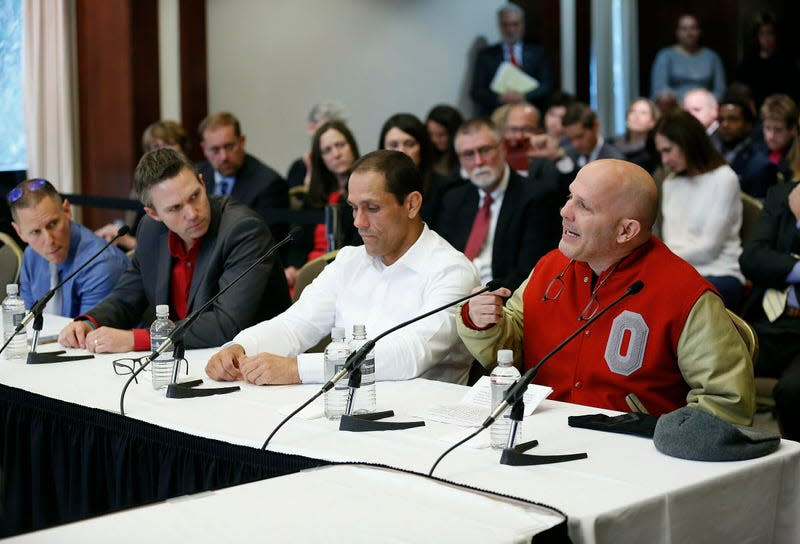Hundreds of Men Were Sexually Abused at Ohio State. The School Is Still Fighting Them.

- Oops!Something went wrong.Please try again later.
It’s been two years since Sports Illustrated asked, “Why Aren’t More People Talking About the Ohio State University Sex Abuse Scandal?” The staggering cover story examined the university’s systemic sex abuse perpetrated by Dr. Richard Strauss, which several high-ranking and well-known university officials failed to report. The magazine called it “the most sweeping sex abuse scandal in the history of American higher education.” Considering Strauss’s abuse spanned two decades, and there are hundreds of known survivors, it wasn’t an exaggeration.
Now, as Strauss’ survivors—all of which are men, with the exception of one woman—continue to seek justice in court, the question of why more people aren’t talking about it is, sadly, more pertinent than ever. This week, the university filed an en banc review, a rare legal practice that some survivors believe is the institution’s latest attempt to thwart their cases being tried in court.
Read more
“Ohio State has continued this rhetoric that they’re sorry and all this stuff, but since day one, they’ve been trying to throw us out of court and not have the facts heard,” Rocky Ratliff, an attorney representing one group of several survivors and a survivor himself, told Jezebel in a phone interview. “Since day one, they have vigorously fought this case, even though they’ve told the press they haven’t.”
Between 1978 and 1998, Strauss, a physician within the university’s athletic department, sexually assaulted hundreds of male athletes under the guise of medical treatment. According to a report commissioned by Ohio State and made public in 2019, Strauss—who died by suicide in 2005—committed at least 1,429 instances of fondling and 47 instances of rape during his tenure. It also found that “university personnel had knowledge of complaints and concerns about Strauss’s conduct as early as 1979 but failed to investigate or act meaningfully.”
Despite this, in September 2021, a federal judge dismissed a Title IX lawsuit filed in 2018 by the survivors after four years of litigation. While Judge Michael H. Watson acknowledged that it was indisputable that Strauss abused hundreds of young men, he ultimately agreed with Ohio State’s argument that the statute of limitations had expired. Though accurate, according to current state law, the university was found to have lobbied against a bill that would’ve waived the state’s statute of limitations for the hundreds of survivors. Additionally, Ratliff and other attorneys argued Watson was hardly impartial to the case, given that not only is he an adjunct professor at the university’s law school, but his wife’s business has financial ties to the university.
“The problem is, we’re not going against any other defendant. We’re going up against Ohio State.”
Immediately, the survivors’ attorneys appealed the ruling, and a year later, one of the three survivor groups won in a 2-1 opinion. (Due to the large number of survivors, three legal teams are representing them in three separate groups.) While the attorneys representing that particular group are now empowered to gather evidence, depose witnesses (one of whom is likely to be Rep. Jim Jordan (R-Ohio), who was an assistant coach at the time of Strauss’s abuse and likely knew about it) and pursue a trial, the university has continued to rail against the survivors, now via the Sixth Circuit of Appeal.
“That means that Ohio State is asking them to reconsider what these judges did and basically, overrule their decision,” Ratliff explained. Ratliff told me that he and fellow survivors see the filing as yet another deterrent to justice. Despite how rarely an en banc review is ever successful, many survivors are struggling to find hope, considering the size and strength of the institution they’re facing.
“Quite frankly, this [an en banc review] is supposed to be harder to do than getting into the Supreme Court. Like one to one and a half percent of all the ones requested get heard,” Ratliff said. “The problem is, we’re not going against any other defendant. We’re going up against Ohio State, and we were already thrown out by what we believe was ‘homer judge,’ meaning he worked for the university, donated to the university, attends all their games, goes to their fundraisers, and his wife has contracts with Ohio State. So, my guys have no confidence in the justice system.”
In an email to Jezebel, Ben Johnson, a university spokesperson, noted that all survivors have been given the “opportunity to settle” and that “Ohio State has reached settlement agreements with more than half the plaintiffs, 296 survivors, for more than $60 million.” Ratliff and another attorney for the survivors, Ilann Maazel, have said that it paled in comparison to the settlements awarded in similar cases of institutional sex abuse, like Larry Nassar and Michigan State University ($500 million), Robert Anderson and the University of Michigan ($490 million), and George Tyndell and the University of Southern California ($852 million).
As for the en banc review, Johnson wrote: “We’ll let the September 26 filings speak for themselves.”

Nine of the 16 judges who sit on the Sixth Circuit of Appeal must agree to a review—a feat that Ratliff says his clients fear is very possible. He noted that while his group has not yet been granted an appeal (their hearing is set for October 25th), he’s already operating as if it will: “We’re one hundred percent going forward with evidence gathering because Ohio State has not been above board about anything that’s happened here.”
Another cause for concern is what the ongoing pursuit of retribution might do to their personal and professional reputation, as more opportunities to speak out against the university have recently become possible. Production has just begun on a documentary film about the abuse. Notably, George Clooney is at the helm and it will debut on HBO. A dozen of the more recognizable survivors have already been approached to participate and tell their respective stories.
“Guys are very worried,” Ratliff said. “I mean, this would affect their livelihoods. They feel that you know, Ohio State can affect a lot of things in central Ohio, and in fact, I personally believe they’re more powerful than the state legislature at this point.”
Even still, Ratliff insists that enough men are willing to continue the fight—be it in a courtroom or the court of public opinion. “Though they have little faith in the justice system, they’re willing to take on the giant that is Ohio State,” he said, “because they have truth on their side.”
More from Jezebel
Sign up for Jezebel's Newsletter. For the latest news, Facebook, Twitter and Instagram.

